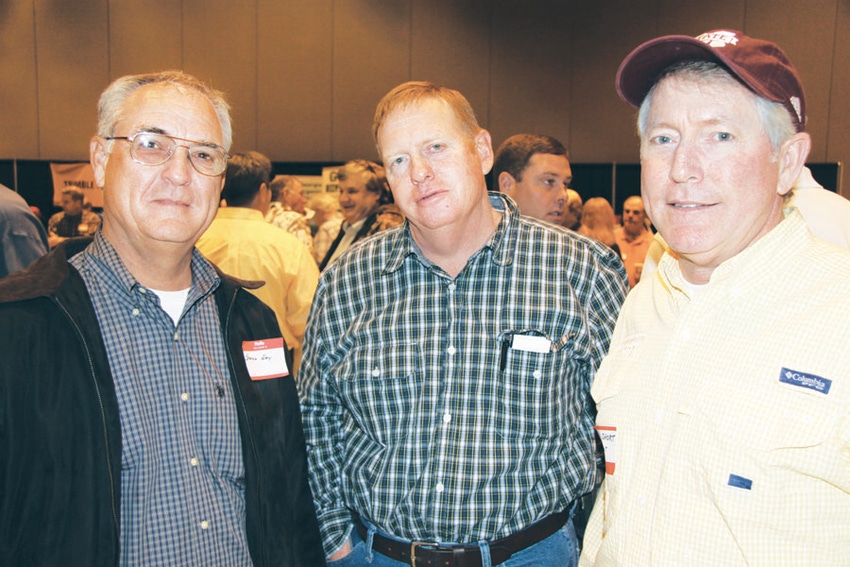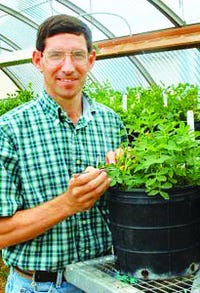
New varieties now becoming available, and others still in the breeding pipeline, will offer growers more options in the type of peanuts they produce — as well as potential for production cost savings.

BARRY TILLMAN
And says breeder Barry Tillman, associate professor of agronomy at the University of Florida’s North Florida Research and Extension Center at Marianna, “Growers have much better choices today; varieties available to growers for 2013 are uniformly excellent.
“Varieties we have today are improved considerably over Georgia Green, which was 78 percent of our acreage just a few years ago,” he said at the annual meeting of the Mississippi Peanut Growers Association. “All of today’s varieties are yielding 5,000 pounds to 6,000 pounds in our irrigated tests; all are very similar in terms of yield. The take-home message is that you aren’t going to suffer very much yield-wise with any of the varieties available today. All have quite high yield potential.”
More peanuts, more infrastructure – Mississippi, Arkansas
In 2012, he says, five varieties constituted the bulk of seed available for purchase in Georgia, Florida, and Alabama. Georgia 06G was the most widely grown, with 77 percent of the seed acres; four others had around 5 percent of certified seed acreage: Tifguard, Georgia 07W, Florida 07, and Georgia Greener.
Two others, at 1 percent and 2 percent respectively, were FloRun 107 and Georgia 09B, high oleic varieties, relatively new to the market and increasing in seed acreage. Seed for both will be limited availability in 2013.
“These two varieties are beginning to get into the seed chain, he says, and should be more available to growers in the next few years,” he says. “Both are yielding quite well in our tests, with excellent grades.
“FloRun 107 is high yielding, with very good grades, medium maturity, good spotted wilt resistance, and moderate white mold resistance. One big advantage is that it has smaller seeds and pods than 06G, which could save you up to $30 per acre in planting costs. Seed will be in limited supply in 2013.
“TUFRunner 727 is high yielding, with excellent grades. It is a bit later in maturity, five to seven days later than Florida 107. Its real strength is its disease package, with excellent white mold resistance and some leaf spot resistance. It’s probably going to be one of the best in its category for white mold resistance. It is very new and available seed will be only for seed producers in 2013.”
In 2010, the University of Georgia released Georgia 10T, a late maturity, normal oleic variety with excellent resistance to spotted wilt, and 2011 released Georgia 11J, a Virginia type peanut with high oleic oil chemistry.
The USDA released Tifguard, a runner variety, in 2007 and seed are now generally available. It is a medium maturity, large-seed runner and the first variety to combine resistance to tomato spotted wilt virus and a high level of resistance to root knot nematodes.
A University of Florida release in 2007, Florida Fancy, is a Virginia type, high oleic runner variety with good resistance to tomato spotted wilt virus. Seed should be available in 2013, primarily in the southwestern production region of Texas.
Plant more than one variety
In choosing varieties, Tillman says, “The thing we really preach to growers is minimizing risk. Last year, 77 percent of our three-state acreage was one variety. That can potentially be very dangerous from a production standpoint, given the potential for disease losses and for the possibility for a variety not reacting favorably in a single environment.

GROWERS attending the annual meeting of the Mississippi Peanut Growers Association includes, from left, Dale Parden, Wiggins, Miss.; Kyles McDuffie, Poplarville, Miss.; and Steve Seward, Lucedale, Miss.
“I really encourage growers to plant more than one variety, and to evaluate new varieties in tests on your own farm. Plant them side by side so you can have a fair comparison of how they perform.”
One significant difference in varieties, Tillman says, is seed size.
“Over the years, we’ve seen an increase in seed size. Georgia Green had small seed, and you could plant fewer pounds per acre to get the same plant stand. It would take 120 pounds per acre of Georgia Green to get the same stand planting at 6 seeds per foot, compared to something like Georgia-06G at 150 pounds per acre. This can make quite a difference in what it costs to plant a crop.
“New varieties such as FloRun 107 and Georgia 109B are quite a bit smaller than the larger-seeded varieties we’re planting today. That could be a difference of as much as 30 or 40 pounds of seed per acre — and at 75 cents to 80 cents per pound, that could save as much as $30 per acre in seed costs.”
Breeders are “working hard,” Tillman says, “to get back to a more normal runner seed size.”
The evolution to larger-seeded varieties has come about, he says, “because the germplasm we were using for crosses had large seed, so our commercial selections have tended to also have large seed. In our numbered and new lines, we have several varieties with smaller seed that are performing quite well, and I think in the future we’ll be seeing releases from all the breeding programs that have smaller seed.”
Seed size is also related to calcium, he says. “Unlike other crops that respond quite well to fertility, in most situations peanuts don’t respond to nitrogen, phosphorus, or potassium. The nutrient we need to pay most attention to is calcium, because of its impact on germination, grade, and yield. The first symptom of minimal or marginal calcium is germination problems. With deficient calcium, peanut seeds can also fail to develop fully, which has an impact on grade.”
To insure adequate calcium, Tillman says, gypsum can be applied.
“For producing commercial farmer stock peanuts, not seed, you should be guided by a pegging zone soil test. If there is less than 500 lbs. of calcium per acre, we recommend applying gypsum. The soil test should be done in the 3-inch pegging zone, not the normal 6-inch soil test. If you’re growing peanuts for seed, we always recommend applying gypsum to insure adequate calcium for germination.
“We don’t recommend foliar calcium — it doesn’t translocate from the leaves into developing pods. Peanut pods have to absorb calcium directly from the soil; this has been proven over 60 or 70 years. The recommended procedure is to apply gypsum at bloom time.”
Applying lime on the soil surface may be effective, Tillman says, “But I emphasize ‘may.’ Some varieties absorb calcium better than others, even if seed size is not a factor. Typically large-seeded varieties require more calcium than smaller-seeded varieties, but not always. Liming the soil surface may be effective, but it does need to be applied well ahead of time to make the calcium available, because it doesn’t break down as quickly as gypsum.
“In varieties we have today, seed size is the primary factor to look at, and with the larger-seeded varieties you want to make sure you have enough calcium to prevent ‘pops’.”
As peanuts get more attention as a health food (the Mississippi Peanut Growers Association was recently certified to use the Heart-Check mark on its promotional peanut packages), high oleic oil varieties are coming to the fore, Tillman says.
“Why is the high oleic trait important? It helps to increase peanut shelf life, so they can stay fresh longer and not become rancid. That’s a big advantage for manufacturers of candies and confectionary products. Our competitors are producing these varieties — peanuts coming out of Argentina, Australia, and other parts of the world are high oleic.
“In tests, after just four weeks normal oleic peanuts were starting to go off flavor, but it took high oleic peanuts 32 weeks to reach the same point. Manufacturers are increasingly requiring us to do offer this, and it’s important for us to be able to compete in these markets.”
In a high oleic peanut variety, total oil is about 80 percent oleic, compared about 60 percent in a normal oleic variety. The linoleic portion of the oil is only 2 percent in a high oleic variety, compared to about 20 percent in a normal oleic variety.
Crop rotation key to curbing diseases
Managing diseases is a major component of a peanut production program, says Tillman, and “I always tell growers there is one thing more than anything else you can do to reduce disease pressure: crop rotation.”
“Peanuts benefit tremendously from rotation with non-legumes such as cotton, corn, sorghum, and we encourage growers to make rotation a key part of their production program.”
New varieties developed by breeders in recent years offer producers a greater choice of the peanuts to grow, he says.
Disease resistance is a significant consideration in variety choice. “In the humid South, there are several diseases that can have an impact on peanut production.”
And while breeders are working to develop varieties that offer broader resistance, he says, “You will be using fungicides to control diseases for the foreseeable future.”
White mold is probably “one of the most important peanut diseases,” Tillman says, but it is one for which there are varieties with “quite good resistance that can help you in your disease management program.” There are also varieties that offer some resistance for leaf spot and spotted wilt.
“We really don’t have examples of immunity for these diseases,” Tillman says, “but there is near immunity in TifGuard to root knot nematodes, which could be an issue in some of the sandier soils in Mississippi.”
Most of the disease resistance in varieties is relative, he says. “We rank them as to how they perform under the same conditions, using a numerical scale like the Peanut RX program, which gives a value for each variety and how it performs for each disease.
“In general, all our newer varieties have pretty good resistance to spotted wilt, and we wouldn’t expect major losses from that disease. We don’t, however, have much resistance to leaf spot; Tifguard is about the best. A new one, TUFRunner 727, probably as good as Tifguard.”
An area where there is considerable potential to chose varieties for resistance is for white mold, Tillman says. “Tifguard, Georgia 07W, and Florida 07 rank high; their yield loss to white mold is much less when disease is present. If this disease is an issue for you, consider these three varieties.”
You might also like:
First-day corn planting always a challenge
Lawsuit could limit fertilizer applications
Irrigation scheduling tools to cut water use
About the Author(s)
You May Also Like




